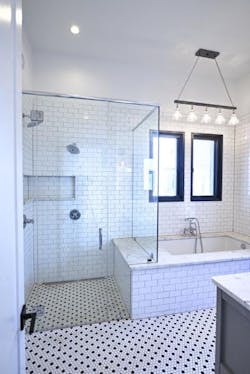Project of the Week: Commercial Sheathing Helps Create a Durable N.C. House
Atlanta-based LG Squared Architects used commercial gypsum-based sheathing from Georgia Pacific to create an energy-efficient and resilient off-the-grid home in North Carolina.
“The client found us through a referral,” says Chris Laumer-Giddens, who, with his wife Jodi, runs LG Squared. “We specialize in high performance design and construction. That’s our bag.”
[ Read More: 2020 HOME EXTERIORS GUIDE: 21 PRODUCTS OFFERING DURABILITY, AESTHETICS ]
High-performance indeed was an important part of the clients’ brief, but Laumer-Giddens says the durability and resiliency of the project also played a huge role. “The clients requested an off-the-grid house that would last a long time,” he explains. The owners, he continues, want to live out the rest of their lives completely off the grid in high performance durable structures that have the ability to resist the weather conditions of this area and the forest fires that are common in the mountains of western North Carolina.
Sited on 103 acres in Hayesville, N.C., the project consists "three buildings arranged around a courtyard,” Laumer-Giddens says. Measuring about 2,800 square feet, the main houses features a courtyard with a covered area, and a water feature and a privacy wall. It also has a barn that does not house animals. Instead, it contains equipment and a storage area for the solar battery backup.
[ Read More: DARK EXTERIOR MATERIALS TELL THE STORY OF THIS HOME'S PAST ]
Because of its location in an area that’s prone to wild fires, the structures had to be highly resistant to such events, but the clients also wanted protection from pests, rot, and the elements. “All of the materials that they considered had to be durable and able to stand up to these things,” the architect says. “Their brief listed metal, steel, concrete, glass, brick, etc. as possible options.
One more important thing had to do with the house’s location in Climate Zone 4. “There is a giant swing in temperature levels and moisture levels throughout the year, so the wall assembly has to manage that moisture well,” Laumer-Giddens explains.
[ Read More: IS IT TIME TO GIVE STRUCTURAL INSULATED PANELS A SECOND LOOK? ]
To handle all of the clients’ request, LG Squared Architects chose steel structural elements, corrugated metal siding, concrete blocks, and steel studs. Instead of traditional plywood or OSB sheathing, the firm chose Georgia Pacific’s DensElement gypsum-based fire resistant sheathing with an integrated water barrier. The firm detailed the sheathing with Prosoco liquid-applied flashing and seam filler, but GP now offers its own branded fluid-applied product, DensDefy.
“DensElement Barrier System is the result of a lot of research and a lot of discovering that buildings fail if you don’t have the right assemblies and pieces in the right places,” the architects say. “When we start taking buildings apart, we see where and how they’re failing, which helps us come up with technologies and design strategies to prevent those failures. DensElement Barrier System is the direct result of careful research into failed buildings. Creating a product like that helps to both educate the professional and offer a way to prevent those failures.”
[ Read More: THE PROS AND CONS OF ENGINEERED LUMBER ]
A combination sheathing, water- and air-resistive barrier, DensElement features a gypsum core and a fiberglass mat facing with what the company calls AquaKor Technology that penetrates into the core. It can be used under a variety of claddings, rigid insulations, and EIFS when the joints, openings, penetrations, material transitions, and fasteners are properly sealed with fluid applied flashing, Georgia Pacific says.
Designed for large commercial or multi-family projects, DensElement made sense for Benoit Farms because it stands up to the elements and has a higher fire resistance than typical OSB or plywood sheathing. In fact, the company says the sheathing is noncombustible “as tested in accordance with ASTM E 136 and CAN/ULC S114, (15.9 mm) is UL classified as Type DGG and is included in many UL and ULC assemblies.”
[ Read More: 9 HOUSEWRAPS THAT BLOCK AIR BUT ALLOW WATER VAPOR TO ESCAPE ]
But can this commercial-grade product work for home building? Laumer-Giddens says thinks so. “I do think DensElement has a place in residential construction, especially where a builder needs fire resistance and protection from water,” he says. “It’s more expensive and it requires more labor. If a construction crew is accustom to use wood-based sheathing you have to use a commercial crew, which increases the cost.
“But a product like this takes care of a lot of issues,” the architect continues. “It handles water better, it gives you more time in case of fire, it manages water better, and it will last a long long time. I could see it being used in special circumstances or locations where the houses needs more protection from the elements.”





